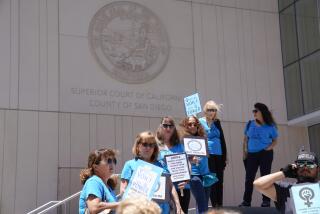Most Police Take Cautious Stance on ‘Megan’s Law’
- Share via
It’s been four weeks since it became legal for police departments to notify residents when a sex offender moves into town, but local authorities Friday acknowledged that it may be a long time before most of them have firm policies on just how to implement the controversial and complex “Megan’s Law.”
Some parents have praised the handful of small departments that have released detailed information about newly arrived sex offenders since the law took effect Jan. 1. But no department contacted Friday seemed ready to do what South Pasadena police did earlier this week--distribute to schools detailed notices about a convicted child rapist who moved into town. A Catholic school sent the notices, including the man’s picture and address, to hundreds of parents--a move that is drawing some criticism, even from supporters of the law.
“This is an area that is still being refined in practice,” said Pasadena Police Cmdr. Mary Schander. “It is something that South Pasadena clearly went out in front on.”
The law allows individual departments to decide whether to publicize the identities and whereabouts of sex offenders. It’s an area where some police fear to tread.
“I’m not aware of any plan within the LAPD to make that kind of notification,” said Cmdr. Eric Lillo, who oversees the Los Angeles Police Department’s juvenile group. Departments like South Pasadena, he said, have “opened up real questions about crime and vigilantism. It could cause some big problems for the departments that have done it.”
The Los Angeles County Sheriff’s Department is still drafting policies on implementation of Megan’s Law.
“We are being careful because of the liability issue and civil rights questions,” Sheriff’s Lt. Gary Doore said.
But the aspect of Megan’s Law that may have the greatest impact is crystal clear: Departments now must make available to the public names and photographs of registered sex offenders within their jurisdictions.
Under directions from state Atty. Gen. Dan Lungren, departments are compiling a CD-ROM database of the state’s 57,000 registered sex offenders covered by the law. That database must be available to the public by July 1 in cities with populations above 200,000.
This will allow the public to find the name, photograph and Zip Code of local sex offenders. Now,anyone who is not a registered sex offender can view binders at LAPD and sheriff’s stations containing that information on 900 offenders statewide who are classified as “high-risk” child molesters.
The CD-ROM will expand that to cover the more than 18,000 registered sex offenders in the county--which includes people convicted of sex crimes against adults--and thousands of others across the state.
Making this information available can be dangerous, says Elizabeth Schroeder, associate director of the Southern California American Civil Liberties Union.
“It again raises the specter of vigilantism,” Schroeder said. There are other worries, she added: “One can never be 100% sure that those lists are accurate. Someone could have moved from that address and the new resident could find himself being picketed.”
Even advocates acknowledge the potential for abuse and say Megan’s Law, named after a New Jersey girl allegedly slain by a paroled molester, must be used carefully.
“Everybody should keep calm and controlled. We begged for this law and now we have to act responsibly,” said Susan Carpenter McMillan, spokeswoman for the Women’s Coalition and resident of a San Marino neighborhood that abuts South Pasadena.
Jayne Murphy Shapiro is president of Kidsafe, a children’s rights group that lobbied heavily for Megan’s Law. But she is not happy at how the statute was applied in what was apparently its first Los Angeles County use.
“I find it irresponsible for police departments to be releasing information on low-level sex offenders like the one in South Pasadena,” Shapiro said.
South Pasadena police were deluged with calls Friday from citizens and reporters.
They said they had carefully thought out their decision to release information on Roger Thomas O’Hare, a convicted child rapist who this month moved within walking distance of five schools. O’Hare has not been convicted of a violent crime for 14 years, authorities said.
A tearful O’Hare told a television news crew Friday that he did not deserve notoriety. “I’d rather be back in jail,” he said.
Acting Police Chief John E. Anderson did not return a call Friday, but in an interview Thursday he said the decision “was not made lightly” and was intentionally limited to schools. Police did not release O’Hare’s address, but an officer apparently passed it on to Holy Family School in what Anderson described as “a leak.”
Holy Family’s principal said she believed she was merely cooperating with police in releasing the information. On Friday, Msgr. Clement Connolly, pastor of Holy Family Church, said he stood by the dissemination.
“Parents have a right to know . . . We are not telling people to do anything. We are not telling them to not forgive this man,” Connolly said.
Earlier this month, Placentia police distributed the name, picture and address of a paroled child molester who had just moved to town. Neighbors picketed his home and called 911 when he stepped outside. The man has since lost his job and was briefly detained on a suspected parole violation.
Both sheriff’s and LAPD officials said decisions on publicizing sex offenders would be made on “a case-by-case basis.” The mechanisms to make those decisions are still being determined.
Other agencies also are hesitant.
“We really haven’t delineated any clear policy yet,” said Long Beach Police Cmdr. Ray Jordan.
“At this point, we’re not using it,” said Downey Police Sgt. James Elsasser. “Our city attorney’s office has advised against it until there are some test cases.”
Times staff writer Nicholas Riccardi contributed to this story.
More to Read
Sign up for Essential California
The most important California stories and recommendations in your inbox every morning.
You may occasionally receive promotional content from the Los Angeles Times.











